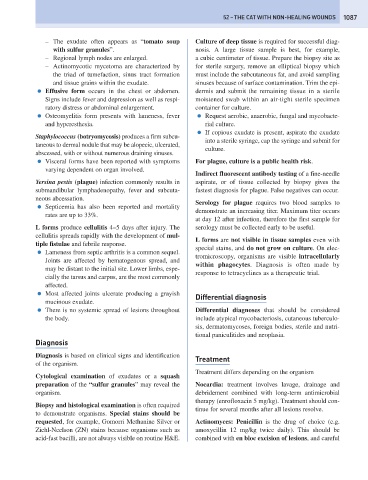Page 1095 - Problem-Based Feline Medicine
P. 1095
52 – THE CAT WITH NON-HEALING WOUNDS 1087
– The exudate often appears as “tomato soup Culture of deep tissue is required for successful diag-
with sulfur granules”. nosis. A large tissue sample is best, for example,
– Regional lymph nodes are enlarged. a cubic centimeter of tissue. Prepare the biopsy site as
– Actinomycotic mycetoma are characterized by for sterile surgery, remove an elliptical biopsy which
the triad of tumefaction, sinus tract formation must include the subcutaneous fat, and avoid sampling
and tissue grains within the exudate. sinuses because of surface contamination. Trim the epi-
● Effusive form occurs in the chest or abdomen. dermis and submit the remaining tissue in a sterile
Signs include fever and depression as well as respi- moistened swab within an air-tight sterile specimen
ratory distress or abdominal enlargement. container for culture.
● Osteomyelitis form presents with lameness, fever ● Request aerobic, anaerobic, fungal and mycobacte-
and hyperesthesia. rial culture.
● If copious exudate is present, aspirate the exudate
Staphylococcus (botryomycosis) produces a firm subcu-
into a sterile syringe, cap the syringe and submit for
taneous to dermal nodule that may be alopecic, ulcerated,
culture.
abscessed, with or without numerous draining sinuses.
● Visceral forms have been reported with symptoms For plague, culture is a public health risk.
varying dependent on organ involved.
Indirect fluorescent antibody testing of a fine-needle
Yersina pestis (plague) infection commonly results in aspirate, or of tissue collected by biopsy gives the
submandibular lymphadenopathy, fever and subcuta- fastest diagnosis for plague. False negatives can occur.
neous abcessation.
Serology for plague requires two blood samples to
● Septicemia has also been reported and mortality
demonstrate an increasing titer. Maximum titer occurs
rates are up to 33%.
at day 12 after infection, therefore the first sample for
L forms produce cellulitis 4–5 days after injury. The serology must be collected early to be useful.
cellulitis spreads rapidly with the development of mul-
L forms are not visible in tissue samples even with
tiple fistulae and febrile response.
special stains, and do not grow on culture. On elec-
● Lameness from septic arthritis is a common sequel.
tromicroscopy, organisms are visible intracellularly
Joints are affected by hematogenous spread, and
within phagocytes. Diagnosis is often made by
may be distant to the initial site. Lower limbs, espe-
response to tetracyclines as a therapeutic trial.
cially the tarsus and carpus, are the most commonly
affected.
● Most affected joints ulcerate producing a grayish
Differential diagnosis
mucinous exudate.
● There is no systemic spread of lesions throughout Differential diagnoses that should be considered
the body. include atypical mycobacteriosis, cutaneous tuberculo-
sis, dermatomycoses, foreign bodies, sterile and nutri-
tional paniculitides and neoplasia.
Diagnosis
Diagnosis is based on clinical signs and identification
Treatment
of the organism.
Treatment differs depending on the organism
Cytological examination of exudates or a squash
preparation of the “sulfur granules” may reveal the Nocardia: treatment involves lavage, drainage and
organism. debridement combined with long-term antimicrobial
therapy (enrofloxacin 5 mg/kg). Treatment should con-
Biopsy and histological examination is often required
tinue for several months after all lesions resolve.
to demonstrate organisms. Special stains should be
requested, for example, Gomorri Methanine Silver or Actinomyces: Penicillin is the drug of choice (e.g.
Ziehl-Neelson (ZN) stains because organisms such as amoxycillin 12 mg/kg twice daily). This should be
acid-fast bacilli, are not always visible on routine H&E. combined with en bloc excision of lesions, and careful

